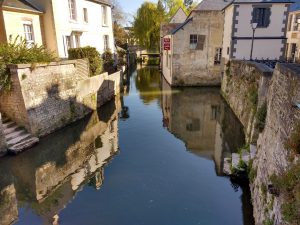It’s one of the most familiar dates in history, when the Normans invaded England and won the Battle of Hastings 950 years ago, on October 14 1066. I visit William the Conqueror’s handsome, historic hometown in Normandy, where the British have favourite visitor status, and track down the links to 1066, the D Day landings, Camembert, fine horses and much more.
Conqueror’s Cathedral.
Is it time we cast off that “biggest home defeat” tag when describing William the Conqueror’s victory over the Saxon king Harold at Hastings, or more correctly nearby Senlac Hill, in Sussex? After all, the Normans left many fine churches, cathedrals and castles, with us to this day. It all began in Normandy, and an outstanding piece of Norman heritage is Bayeux Cathedral. William consecrated it in 1077, and it may have been here where Harold swore the controversial oath of loyalty to William. An hour by road from Bayeux is the Château de Falaise, where William was born and raised, although the tremendous edifice we see today dates from the 1100s. It’s the work of his son Henry I, based on the Norman castles built in England after the Conquest.
British Bayeux
Bayeux warmly welcomes the British. The town, 40 minutes from the D-Day beaches, was unscathed during the subsequent Battle of Normandy. Units of the British army liberated it on 7th June 1944, the day after the occupying Germans fled, the first French city to be freed in the campaign. On my visit in 2016, as in all anniversary weeks, the town was dripping with Union flags. There are “Welcome to our Liberators” signs in the windows of restaurants and shops. The largest Second World War British military cemetery is at Bayeux. There are pleasant strolls around narrow streets, with picturesque vantage points down by the river Aure. I recommend L’Angle Saint Laurent restaurant, for good, no-fuss French cooking. www.langlesaintlaurent.com
Top tapestry
The victors always get to tell the story of a war. The account of the successful campaign culminating in the Battle of Hastings, the 230 ft long Bayeux Tapestry, is one of the best, and earliest examples. Its survival almost intact over nine centuries has been called “little short of a miracle”. Commissioned in the 1070s, it was stitched, it is believed in England, with the highest skill, out of dyed, spun wool. It is on permanent display, under low lighting in the Bayeux Museum. The audio guide explains the action in the 50 scenes. Look, too, at the fascinating goings-on in the borders. They include the earliest known depiction of Halley’s Comet, and of the newly invented harrow. You may embroider your own tapestry, in a kit from Bayeux Broderie. It is run by Chantal James, master-craftswoman and specialist of Bayeux stitch embroidery. She opened her new shop at 24, rue de Desmond in 2016.
Rural retreat
We stayed at the Château La Cheneviere, (www.lacheneviere.com), a shining example of how a determined family with a vision can turn a dilapidated old wreck of an 18th century building they bought in 1988 into a five star resort. It’s an elegant and peaceful retreat in the countryside, about 6 miles from Bayeux and 22 miles from Caen-Carpiquet airport, set around with majestic trees. The château has its own highly-rated restaurant, and it serves a super breakfast, distinguished with bread and pastries from the illustrious Fournil de Saint Loup bakery, and honey from its own hives. This is a good base to explore the beaches and countryside of the 1944 Battle of Normandy.
Smooth crossing
I reached Normandy on the easiest, low-stress flight I have taken in years. Flybe make the short hop from little, uncrowded Southend Airport (www.southendairport.com, direct trains from Liverpool St) to Caen Carpiquet Airport in under an hour. Normandy is a fertile land, rich in milk and apples and cheese. It is a place for pleasant wanderings between pretty little villages and small ports. There’s a rich scatter of ancient churches, historic buildings, tearooms and restaurants. The Michelin star Le Pavé d’Auge in the pretty village of Beuvron is one I enjoyed. We took a stroll in seaside Trouville, where Marcel Proust lived. And Port-en-Bessin, where the PLUTO pipeline which fuelled the 1944 invasion came ashore from England.
Tucked away treasure
France is good at promoting worthwhile little areas you might otherwise drive straight past. The Orne department, in the south of Normandy, proves this point. Domfront (57 miles from Bayeux) with its Plantagenet castle and cathedral, is the crossroads of two great cycling routes: the 280 miles long Paris to Mont St-Michel Velsocenic; and the Vélo Francette, Caen to La Rochelle route (390 miles). The National Equestrian Stud Farm (“Versailles of the Horse”) is at Haras du Pin. They still make, by hand, the famous namesake soft cheese at the village of Camembert. Argentan has two 15th Century churches, a castle and a C14th chapel. Mortagne au Perche is France’s “Home of the Black Pudding” and good place to look for antiques.
Further information:
http://bayeux-bessin-tourisme.com
Gareth flew courtesy of Flyby www.flybe.com

